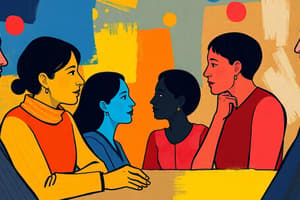Podcast
Questions and Answers
What distinguishes human communication from animal communication?
What distinguishes human communication from animal communication?
- The perception of different contour types
- The preference for infant-directed speech
- The use of vocal melodies
- The understanding of the mental states of others (correct)
What type of speech do infants prefer over adult-directed speech?
What type of speech do infants prefer over adult-directed speech?
- Speech with different contour types
- Speech in a familiar language
- Speech conveying emotion and social situations (correct)
- Speech with varied intonations
At what age can infants differentiate between happy and angry faces based on their features?
At what age can infants differentiate between happy and angry faces based on their features?
- 5 months
- 8 months (correct)
- 1 year
- 12 months
In the visual cliff experiment, why might an infant avoid crossing the cliff?
In the visual cliff experiment, why might an infant avoid crossing the cliff?
At what age do infants shift from responding directly to stimuli to attempting to share their experiences with others?
At what age do infants shift from responding directly to stimuli to attempting to share their experiences with others?
What do vocal melodies of infant-directed speech convey to infants?
What do vocal melodies of infant-directed speech convey to infants?
What is the significance of gaze following before 8 months?
What is the significance of gaze following before 8 months?
What does joint attention between an adult and an infant involve?
What does joint attention between an adult and an infant involve?
How does an infant demonstrate learning to follow an adult's gaze at around 12 months?
How does an infant demonstrate learning to follow an adult's gaze at around 12 months?
Why is the duration of looking in the proper direction positively associated with faster vocab growth up to 2 years old?
Why is the duration of looking in the proper direction positively associated with faster vocab growth up to 2 years old?
In what scenario will an infant follow an adult's gaze?
In what scenario will an infant follow an adult's gaze?
What do infants learn at 12 months about objects providing intentional cues?
What do infants learn at 12 months about objects providing intentional cues?
At what age do infants start to interpret a point as long as the object is close to the pointer's finger?
At what age do infants start to interpret a point as long as the object is close to the pointer's finger?
What can communicative pointing (pointing and then looking to adult for confirmation) predict in infants?
What can communicative pointing (pointing and then looking to adult for confirmation) predict in infants?
What happens at 14 months regarding infants and pointing?
What happens at 14 months regarding infants and pointing?
What might babbled sounds provide for infants?
What might babbled sounds provide for infants?
What are the stages of babbling before infants start forming their first words?
What are the stages of babbling before infants start forming their first words?
At what age do babbling and conventional words occur together?
At what age do babbling and conventional words occur together?
What tends to increase the rate of vocalization in infants?
What tends to increase the rate of vocalization in infants?
What type of movements do deaf children exposed to sign language produce?
What type of movements do deaf children exposed to sign language produce?
How do hearing infants communicate before they speak first words?
How do hearing infants communicate before they speak first words?
What purpose do gestures serve in relation to language development?
What purpose do gestures serve in relation to language development?
'Symbolic gestures' mentioned in the text refer to gestures that:
'Symbolic gestures' mentioned in the text refer to gestures that:
At what age do symbolic signs and first words typically emerge?
At what age do symbolic signs and first words typically emerge?
Why is iconicity mentioned in relation to early signs?
Why is iconicity mentioned in relation to early signs?
What do parent checklists suggest about infants' understanding of language?
What do parent checklists suggest about infants' understanding of language?
What do infants typically recognize at 8 months related to language?
What do infants typically recognize at 8 months related to language?
When do infants become efficient at recognizing familiar words, even before completion?
When do infants become efficient at recognizing familiar words, even before completion?
Why is it mentioned that some infants will produce both sign and speech at the same rate?
Why is it mentioned that some infants will produce both sign and speech at the same rate?
What is the term used to describe when infants start experimenting with a wide array of noises they can make with their vocal tracts?
What is the term used to describe when infants start experimenting with a wide array of noises they can make with their vocal tracts?
At what age do infants typically transition from reduplicated babbling to variegated babbling?
At what age do infants typically transition from reduplicated babbling to variegated babbling?
What is the significance of gaze following before 8 months?
What is the significance of gaze following before 8 months?
What happens during the 'jargon' babbling stage in infants' language development?
What happens during the 'jargon' babbling stage in infants' language development?
At what age do infants typically switch to learning how to follow an adult's gaze?
At what age do infants typically switch to learning how to follow an adult's gaze?
What is the significance of canonical babbling in infants around 6-7 months?
What is the significance of canonical babbling in infants around 6-7 months?
What do infants typically progress from at 6-7 months to form more complex babbling sounds?
What do infants typically progress from at 6-7 months to form more complex babbling sounds?
Why is duration of looking in the proper direction positively associated with faster vocab growth up to 2 years old?
Why is duration of looking in the proper direction positively associated with faster vocab growth up to 2 years old?
What do infants learn about pointing at 12 months?
What do infants learn about pointing at 12 months?
How do infants demonstrate learning to follow an adult's gaze at around 12 months?
How do infants demonstrate learning to follow an adult's gaze at around 12 months?
What is the relationship between mother's verbal response and infant vocalization rate?
What is the relationship between mother's verbal response and infant vocalization rate?
What is a characteristic of deaf children's babbling compared to hearing children?
What is a characteristic of deaf children's babbling compared to hearing children?
What communicative function do hearing infants' gestures serve before they speak their first words?
What communicative function do hearing infants' gestures serve before they speak their first words?
Why do infants show an increased sensitivity to emotion in the voice at 5 months of age?
Why do infants show an increased sensitivity to emotion in the voice at 5 months of age?
What do 1-year-old infants start developing that allows them to understand unspoken inferences via facial expressions?
What do 1-year-old infants start developing that allows them to understand unspoken inferences via facial expressions?
What is the significance of infants referencing their mother's facial expressions (happy or fearful) in the visual cliff experiment?
What is the significance of infants referencing their mother's facial expressions (happy or fearful) in the visual cliff experiment?
Why do 12-month-old infants look at their mother's face to seek information about the world around them?
Why do 12-month-old infants look at their mother's face to seek information about the world around them?
What is the transition that occurs in infants at 9 months related to responding to stimuli?
What is the transition that occurs in infants at 9 months related to responding to stimuli?
What type of speech do infants of all languages generally prefer over adult-directed speech?
What type of speech do infants of all languages generally prefer over adult-directed speech?
What milestone do symbolic signs and first words typically emerge around?
What milestone do symbolic signs and first words typically emerge around?
What do parent checklists suggest about infants' understanding of language?
What do parent checklists suggest about infants' understanding of language?
What is the significance of iconicity in early signs referred to in the text?
What is the significance of iconicity in early signs referred to in the text?
At what age might infants have learned the association between a parent and a parent’s name?
At what age might infants have learned the association between a parent and a parent’s name?
What do early comprehension skills at 8 months entail for infants?
What do early comprehension skills at 8 months entail for infants?
Flashcards are hidden until you start studying





